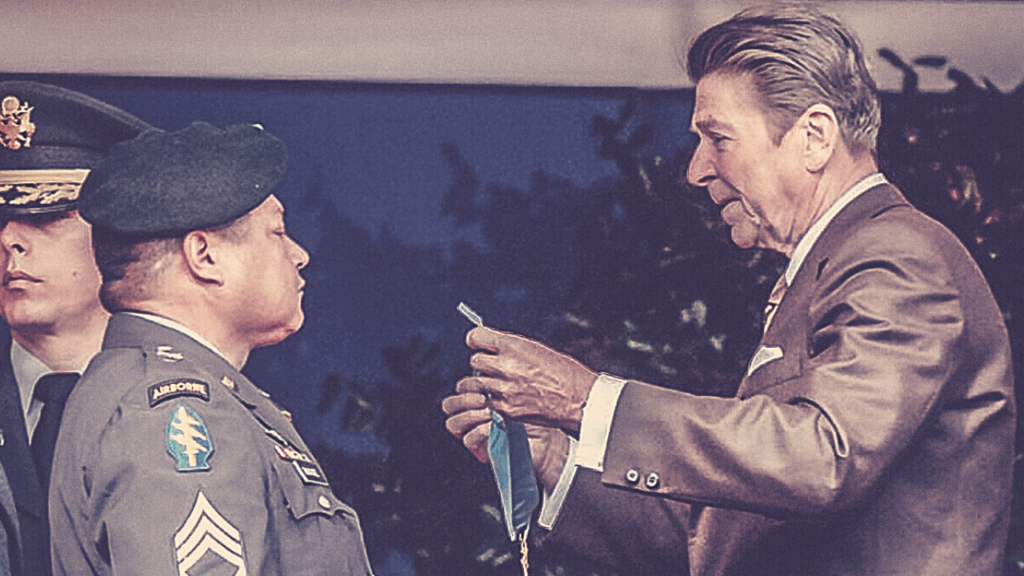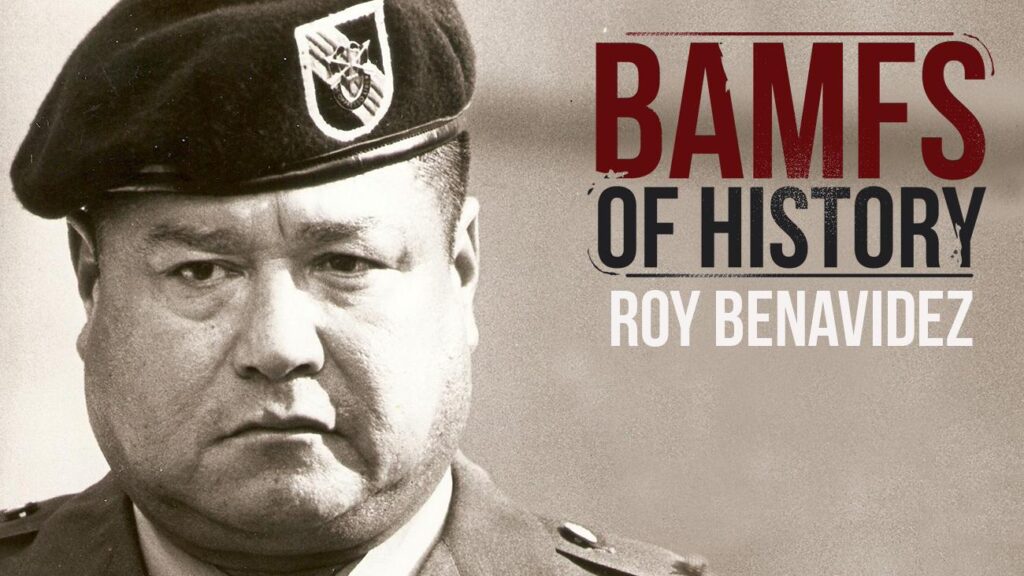Roy Benavidez was born on August 5, 1935, in Lindenau, Texas.
During the Korean War, he enlisted in the Texas Army National Guard in 1952, and in June 1955, he was transferred to the Army’s active duty. He finished his airborne school in 1959 and was then given his assignment at Fort Bragg, North Carolina’s 82nd Airborne Division.
The Warrior Ethos is tucked away inside the Soldier’s Creed, which is something that every member of the contemporary Army learns in basic training: “I will always put the objective first. Never will I concede defeat.

I’ll never give up. Never will I abandon a fallen comrade. Roy Benavidez would have been the epitome of the Warrior Ethos if the Army had done so.
Throughout his life, Benavidez embodied both mental and physical toughness, and on May 2, 1968, at LocNinh, Cambodia, when he was awarded the Medal of Honor, he exemplified the Warrior Ethos.
Benavidez joined the 82d Airborne Division after completing the MP program and was sent to Vietnam as an advisor by 1965.
Benavidez stumbled on a land mine while on patrol with a South Vietnamese Army Regiment, and he “woke up in the Philippine Islands, in Clark Air Force Base,” paralyzed from the waist down.
Doctors at Fort Sam Houston in Texas gave him the bad news when he arrived: his spine had suffered too much damage. Benavidez was informed that he might never be able to walk again and that the Army would medically release him.
Roy Benavidez had different thoughts. He started a nightly personal workout schedule in an effort to rejoin his teammates after refusing to give up.
Every night, he pushed himself out of bed, over to the wall, and slowly reconstructed his legs in a nightly practice that he later claimed frequently left him in tears, against medical advice but with the support of the other Soldiers in his hospital ward (many of them were amputees).
Benavidez moved from sitting to standing to shuffling along the wall in silence, away from his ward mates.
Benavidez was able to get out of bed and walk when the physicians delivered his final release paperwork months later; instead of sending him home, the Army compressed 18 months of physical treatment into six and transferred him to Fort Bragg, North Carolina.

Benavidez could hardly move upon his return to the 82d Airborne. After six months, he was able to run 10 kilometers while carrying a backpack.
Benavidez returned to Vietnam in 1968 after completing Special Forces selection 1967 and receiving training as a weapons specialist. He was then assigned to the 5th Special Forces Group.
Benavidez went there and asked to be assigned to Detachment B-56, which was run by the Military Assistance Command Vietnam, Studies and Observation Group (MACV-SOG).
Benavidez nearly evaded a patrol in April 1968, saving his life thanks to Sgt. 1st Class LeRoy Wright.
Wright and Benavidez had been friends since they were in the 82d Airborne Division, and after going through Special Forces Selection together, they were reunited in Detachment B-56.
On May 2, 1968, Benavidez was on his way home from Catholic Mass when he heard a frantic radio cry for assistance. Wright was a member of an under assault 12-man team,
Benavidez discovered (three Special Forces Soldiers and nine Vietnamese Montagnards, or Mountain Men).
In order to obtain intelligence about reported widespread enemy activity, a 12-man Special Forces reconnaissance team was dropped by helicopter into a dense jungle area west of LocNinh, Vietnam, on the morning of May 2, 1968.
The North Vietnamese troops maintained authority over the area and patrolled it frequently. Shortly after arriving on the ground, the crew encountered fierce enemy opposition and asked for an emergency extraction.
Due to heavy enemy small weapons and anti-aircraft fire, three helicopters made an attempt at extraction but were unable to land.
Benavidez was at a forward operating base in LocNinh monitoring the operation by radio when the helicopters that attempted the extraction returned to off-load injured crewmembers and assess aircraft damage while he was assigned to Detachment B56, 5th Special Forces Group (Airborne), 1st Special Forces, Republic of Vietnam. Benavidez willingly boarded a departing plane to help with a subsequent effort at extraction.
He piloted the aircraft to a nearby clearing where he leaped from the hovering chopper and raced roughly 75 meters under heavy small arms fire to the damaged team after realizing that all of the team members were either dead or wounded and unable to advance to the pickup zone.
He suffered injuries to his right leg, face, and head before getting to where the team was.

Despite being hurt, Benavidez assumed command, moving the squad members and controlling their fire to allow an extraction plane to land and carry the team’s dead and wounded members.
Then, in order to guide the aircraft to the team’s location, he threw smoke canisters.
He carried and dragged half of the injured team members to the waiting aircraft despite suffering from severe wounds and coming under heavy enemy fire.
The aircraft then moved to pick up the remaining squad members as he ran alongside it to give protective fire.
He hastened to retrieve the body and the team leader’s confidential documents as the enemy’s fire increased.
Benavidez was severely hurt by small weapons fire in his belly and grenade shrapnel in his back when he arrived at the leader’s body.
The helicopter pilot’s aircraft crashed and he was fatally injured almost simultaneously. Benavidez, who was suffering from several wounds and was in extremely serious condition, managed to retrieve the sensitive papers and return to the scene of the accident.
There, he helped the injured escape the crashed plane and gathered the bewildered survivors into a protective circle.
He proceeded around the perimeter giving the guys water and ammunition as enemy automatic weapons and grenade fire increased. In order to allow for another attempt at evacuation while facing a buildup of enemy resistance with a beleaguered crew,
Benavidez summoned his courage, started ordering tactical air strikes, and controlled the fire from supporting gunships.
While providing first aid to a hurt team member just before another extraction chopper could land, he was hit by small weapons fire in his thigh once more.
He started transporting the soldiers to the airplane, and when returning with the injured, he was struck from behind by an enemy soldier.
He received more injuries to his head and arms during the next hand-to-hand combat before slaying the foe. He then continued to transfer the wounded to the chopper while under fire.
When he got to the helicopter, he saw two enemy soldiers charging it from an angle that made it impossible for the door gunner to shoot at them, and he killed them.
He made one final journey to the perimeter with little energy left to make sure that all secret material had been gathered or destroyed and to bring in the remaining wounded. He didn’t consent to be taken into the evacuation aircraft until after that.
At least eight men’s lives were spared thanks to Benavidez’s actions.
Benavidez had 37 bullet and bayonet puncture wounds during the six hours of nonstop surgery, in addition to having his jaw fractured. He had been so badly beaten that his commanding officer did not think he would survive long enough to get the Medal of Honor.
As the Distinguished Service Cross would be given out more quickly, this man was nominated for it instead. Benavidez, though, made it through and was awarded the Distinguished Service Cross (DSC). General William C. Westmoreland, who had given Benavidez the DSC, discovered the specifics of Benavidez’s bravery years later.
After that, he proposed that he be upgraded to the Medal of Honor. In 1981, Benavidez was presented with the medal at a White House ceremony by President Ronald Reagan.

Over the course of his outstanding career, Benavidez won the Purple Heart in addition to the Medal of Honor and many other honors.
The Roy P. Benavidez American Legion Post #400 in San Antonio, Texas, and the Roy P. Benavidez City Park in Colorado Springs, Colorado, are just two of the many places that bear his name.
Benavidez died on November 29, 1998. He is buried in San Antonio at the Fort Sam Houston National Cemetery.
If you want to know more about Roy Benavidez click on this link: Roy Benavidez
